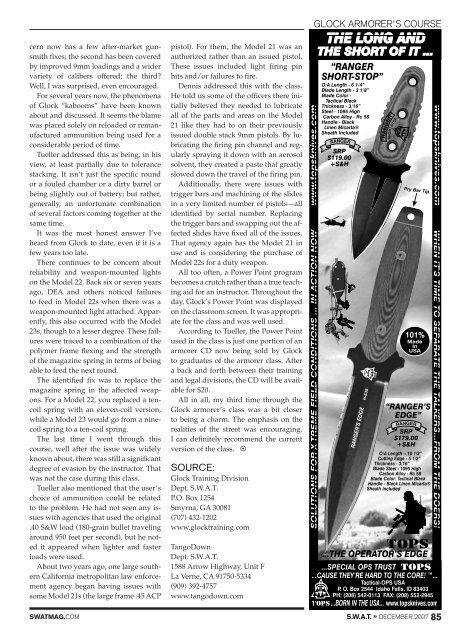S.W.A.T. December 2007 - McKeesport Police Department
S.W.A.T. December 2007 - McKeesport Police Department
S.W.A.T. December 2007 - McKeesport Police Department
Create successful ePaper yourself
Turn your PDF publications into a flip-book with our unique Google optimized e-Paper software.
cern now has a few after-market gunsmith<br />
fixes; the second has been covered<br />
by improved 9mm loadings and a wider<br />
variety of calibers offered; the third?<br />
Well, I was surprised, even encouraged.<br />
For several years now, the phenomena<br />
of Glock “kabooms” have been known<br />
about and discussed. It seems the blame<br />
was placed solely on reloaded or remanufactured<br />
ammunition being used for a<br />
considerable period of time.<br />
Tueller addressed this as being, in his<br />
view, at least partially due to tolerance<br />
stacking. It isn’t just the specific round<br />
or a fouled chamber or a dirty barrel or<br />
being slightly out of battery; but rather,<br />
generally, an unfortunate combination<br />
of several factors coming together at the<br />
same time.<br />
It was the most honest answer I’ve<br />
heard from Glock to date, even if it is a<br />
few years too late.<br />
There continues to be concern about<br />
reliability and weapon-mounted lights<br />
on the Model 22. Back six or seven years<br />
ago, DEA and others noticed failures<br />
to feed in Model 22s when there was a<br />
weapon-mounted light attached. Apparently,<br />
this also occurred with the Model<br />
23s, though to a lesser degree. These failures<br />
were traced to a combination of the<br />
polymer frame flexing and the strength<br />
of the magazine spring in terms of being<br />
able to feed the next round.<br />
The identified fix was to replace the<br />
magazine spring in the affected weapons.<br />
For a Model 22, you replaced a tencoil<br />
spring with an eleven-coil version,<br />
while a Model 23 would go from a ninecoil<br />
spring to a ten-coil spring.<br />
The last time I went through this<br />
course, well after the issue was widely<br />
known about, there was still a significant<br />
degree of evasion by the instructor. That<br />
was not the case during this class.<br />
Tueller also mentioned that the user’s<br />
choice of ammunition could be related<br />
to the problem. He had not seen any issues<br />
with agencies that used the original<br />
.40 S&W load (180-grain bullet traveling<br />
around 950 feet per second), but he noted<br />
it appeared when lighter and faster<br />
loads were used.<br />
About two years ago, one large southern<br />
California metropolitan law enforcement<br />
agency began having issues with<br />
some Model 21s (the large frame .45 ACP<br />
pistol). For them, the Model 21 was an<br />
authorized rather than an issued pistol.<br />
These issues included light firing pin<br />
hits and/or failures to fire.<br />
Dennis addressed this with the class.<br />
He told us some of the officers there initially<br />
believed they needed to lubricate<br />
all of the parts and areas on the Model<br />
21 like they had to on their previously<br />
issued double stack 9mm pistols. By lubricating<br />
the firing pin channel and regularly<br />
spraying it down with an aerosol<br />
solvent, they created a paste that greatly<br />
slowed down the travel of the firing pin.<br />
Additionally, there were issues with<br />
trigger bars and machining of the slides<br />
in a very limited number of pistols—all<br />
identified by serial number. Replacing<br />
the trigger bars and swapping out the affected<br />
slides have fixed all of the issues.<br />
That agency again has the Model 21 in<br />
use and is considering the purchase of<br />
Model 22s for a duty weapon.<br />
All too often, a Power Point program<br />
becomes a crutch rather than a true teaching<br />
aid for an instructor. Throughout the<br />
day, Glock’s Power Point was displayed<br />
on the classroom screen. It was appropriate<br />
for the class and was well used.<br />
According to Tueller, the Power Point<br />
used in the class is just one portion of an<br />
armorer CD now being sold by Glock<br />
to graduates of the armorer class. After<br />
a back and forth between their training<br />
and legal divisions, the CD will be available<br />
for $20.<br />
All in all, my third time through the<br />
Glock armorer’s class was a bit closer<br />
to being a charm. The emphasis on the<br />
realities of the street was encouraging.<br />
I can definitely recommend the current<br />
version of the class. §<br />
SOURCE:<br />
Glock Training Division<br />
Dept. S.W.A.T.<br />
P.O. Box 1254<br />
Smyrna, GA 30081<br />
(707) 432-1202<br />
www.glocktraining.com<br />
TangoDown<br />
Dept. S.W.A.T.<br />
1588 Arrow Highway, Unit F<br />
La Verne, CA 91750-5334<br />
(909) 392-4757<br />
www.tangodown.com<br />
GLOCK ARMORER’S COURSE<br />
SWATMAG.COM S.W.A.T. » DECEMBER <strong>2007</strong> 85


